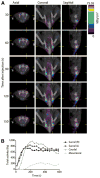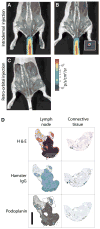Positron lymphography: multimodal, high-resolution, dynamic mapping and resection of lymph nodes after intradermal injection of 18F-FDG
- PMID: 22872741
- PMCID: PMC3537831
- DOI: 10.2967/jnumed.112.104349
Positron lymphography: multimodal, high-resolution, dynamic mapping and resection of lymph nodes after intradermal injection of 18F-FDG
Abstract
The lymphatic system plays a critical role in the maintenance of healthy tissues. Its function is an important indicator of the presence and extent of disease. In oncology, metastatic spread to local lymph nodes (LNs) is a strong predictor of poor outcome. Clinical methods for the visualization of LNs involve regional injection and tracking of (99m)Tc-sulfur colloid ((99m)Tc-SC) along with absorbent dyes. Intraoperatively, these techniques suffer from the requirement of administration of multiple contrast media ((99m)Tc-SC and isosulfan blue), unwieldy γ-probes, and a short effective surgical window for dyes. Preclinically, imaging of transport through the lymphatics is further hindered by the resolution of lymphoscintigraphy and SPECT. We investigated multimodal imaging in animal models using intradermal administration of (18)F-FDG for combined diagnostic and intraoperative use. PET visualizes LNs with high sensitivity and resolution and low background. Cerenkov radiation (CR) from (18)F-FDG was evaluated to optically guide surgical resection of LNs.
Methods: Imaging of (18)F-FDG uptake used PET and sensitive luminescent imaging equipment (for CR). Dynamic PET was performed in both sexes and multiple strains (NCr Nude, C57BL/6, and Nu/Nu) of mice. Biodistribution confirmed the uptake of (18)F-FDG and was compared with that of (99m)Tc-SC. Verification of uptake and the ability to use (18)F-FDG CR to guide nodal removal were confirmed histologically.
Results: Intradermal injection of (18)F-FDG clearly revealed lymphatic vessels and LNs by PET. Dynamic imaging revealed rapid and sustained labeling of these structures. Biodistribution of the radiotracer confirmed the active transport of radioglucose in the lymphatics to the local LNs and over time into the general circulation. (18)F-FDG also enabled visualization of LNs through CR, even before surgically revealing the site, and guided LN resection.
Conclusion: Intradermal (18)F-FDG can enhance the preclinical investigation of the lymphatics through dynamic, high-resolution, and quantitative tomographic imaging. Clinically, combined PET/Cerenkov imaging has significant potential as a single-dose, dual-modality tracer for diagnostics (PET/CT) and guided resection of LNs (Cerenkov optical).
Conflict of interest statement
No other potential conflict of interest relevant to this article was reported.
Figures






Similar articles
-
Positron Lymphography via Intracervical 18F-FDG Injection for Presurgical Lymphatic Mapping in Cervical and Endometrial Malignancies.J Nucl Med. 2020 Aug;61(8):1123-1130. doi: 10.2967/jnumed.119.230714. Epub 2020 Jan 10. J Nucl Med. 2020. PMID: 31924717 Free PMC article. Clinical Trial.
-
Dynamic 18F-FDG PET Lymphography for In Vivo Identification of Lymph Node Metastases in Murine Melanoma.J Nucl Med. 2018 Feb;59(2):210-215. doi: 10.2967/jnumed.117.196303. Epub 2017 Sep 14. J Nucl Med. 2018. PMID: 28912145 Free PMC article.
-
The diagnostic ability of 18F-FDG PET/CT for mediastinal lymph node staging using 18F-FDG uptake and volumetric CT histogram analysis in non-small cell lung cancer.Eur Radiol. 2016 Dec;26(12):4515-4523. doi: 10.1007/s00330-016-4292-8. Epub 2016 Mar 4. Eur Radiol. 2016. PMID: 26943133
-
New horizons for imaging lymphatic function.Ann N Y Acad Sci. 2008;1131:13-36. doi: 10.1196/annals.1413.002. Ann N Y Acad Sci. 2008. PMID: 18519956 Free PMC article. Review.
-
Cerenkov imaging.Adv Cancer Res. 2014;124:213-34. doi: 10.1016/B978-0-12-411638-2.00006-9. Adv Cancer Res. 2014. PMID: 25287690 Free PMC article. Review.
Cited by
-
Positron Lymphography via Intracervical 18F-FDG Injection for Presurgical Lymphatic Mapping in Cervical and Endometrial Malignancies.J Nucl Med. 2020 Aug;61(8):1123-1130. doi: 10.2967/jnumed.119.230714. Epub 2020 Jan 10. J Nucl Med. 2020. PMID: 31924717 Free PMC article. Clinical Trial.
-
Utilizing the power of Cerenkov light with nanotechnology.Nat Nanotechnol. 2017 Feb 7;12(2):106-117. doi: 10.1038/nnano.2016.301. Nat Nanotechnol. 2017. PMID: 28167827 Free PMC article. Review.
-
Cerenkov luminescence imaging: physics principles and potential applications in biomedical sciences.EJNMMI Phys. 2017 Dec;4(1):14. doi: 10.1186/s40658-017-0181-8. Epub 2017 Mar 11. EJNMMI Phys. 2017. PMID: 28283990 Free PMC article. Review.
-
Sentinel lymph node mapping and staging in endometrial cancer: A Society of Gynecologic Oncology literature review with consensus recommendations.Gynecol Oncol. 2017 Aug;146(2):405-415. doi: 10.1016/j.ygyno.2017.05.027. Epub 2017 May 28. Gynecol Oncol. 2017. PMID: 28566221 Free PMC article. Review.
-
Near-Infrared Intraoperative Chemiluminescence Imaging.ChemMedChem. 2016 Sep 20;11(18):1978-82. doi: 10.1002/cmdc.201600301. Epub 2016 Jul 29. ChemMedChem. 2016. PMID: 27471800 Free PMC article.
References
-
- Alitalo K, Tammela T, Petrova TV. Lymphangiogenesis in development and human disease. Nature. 2005;438:946–953. - PubMed
-
- Lucey BC, Stuhlfaut JW, Soto JA. Mesenteric lymph nodes seen at imaging: causes and significance. Radiographics. 2005;25:351–365. - PubMed
-
- Balch CM, Buzaid AC, Soong SJ, et al. Final version of the American Joint Committee on Cancer Staging System for cutaneous melanoma. J Clin Oncol. 2001;19:3635–3648. - PubMed
-
- Gershenwald JE, Thompson W, Mansfield PF, et al. Multi-institutional melanoma lymphatic mapping experience: the prognostic value of sentinel lymph node status in 612 stage I or II melanoma patients. J Clin Oncol. 1999;17:976–983. - PubMed
-
- Pagliarulo V, Hawes D, Brands FH, et al. Detection of occult lymph node metastases in locally advanced node-negative prostate cancer. J Clin Oncol. 2006;24:2735–2742. - PubMed
Publication types
MeSH terms
Substances
Grants and funding
LinkOut - more resources
Full Text Sources
Other Literature Sources
Research Materials
